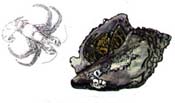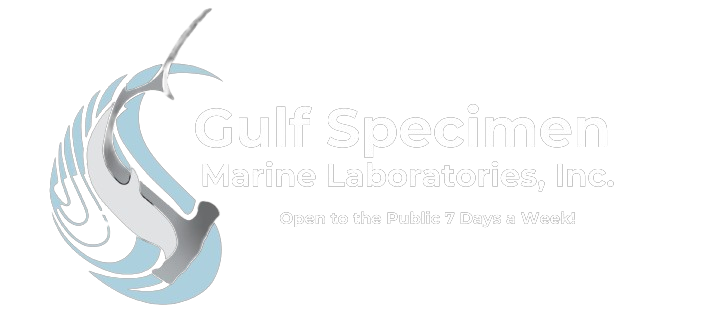 |
Spotted Sea Trout – Cynoscion nebulosa Spotted or Speckled Sea Trout are found in the warm, shallow bays and estuaries south of Chesapeake Bay to the Gulf of Mexico. They are aggresive predators, feeding on fish, crustaceans, and squid. They are fighters on a hook, but are delicate. Their jaws are weak and easily torn, and many die during hook removal. But, because of their desperate fight and delicious taste, they are prized by fishermen. Family: Sciaenidae/Drums |
 |
Staghorn Bryozoan – Schizoporella unicornis Although it looks like coral, it is not. A much more complex animal, made of thousands of compartments of tiny zooids that capture microscopic plants from the water with fan-like appendages. Usually orange in color, it is a mini-habitat for crabs, small shrimp, and hat shells. Class: Gymnolaemata |
 |
Stinging Nettle Jellyfish – Chrysaora quinquecirrha One of the most common jellyfish of the Atlantic and Gulf coasts. The umbrella is pale white with red lines resembling the spokes of a wheel. Fine reddish tentacles trailing from the bell are covered with stinging cells and are instant death to small fish and other creatures that pass by them. Swimmers who come in contact with them experience a painful burning and stinging sensation and inflammation which soon disappears. Class: Scyphozoa |
 |
Stone Crab – Menippe mercenaria The largest of all mud crabs, it uses two huge grinding claws to crush oysters. One is for crushing, the other for delicately picking out the meat. Stone crab claws are an epicurean dish: the fishermen break off one claw and throw the crab back to regenerate a new one. It is perhaps the only living creature that you can eat partially while the rest of the animal is running around trying to survive. Lives in burrows amidst rocks and oyster bars. Subphylum: Crustacea, Infraorder: Brachyura |
 |
Striped Hermit Crab – Clibanarius vittaltus The most common of all hermits in the Florida panhandle, they frequent the upper intertidal zone, often crawling up sea walls and on dead tree stumps to be stranded at low tide. Like most hermits, they forage on dead animals, worms, etc., but often stay withdrawn in their borrowed shells. Subphylum: Crustacea, Infraorder: Anomura |
| « Previous | Next » |





